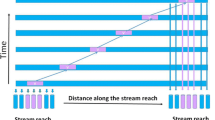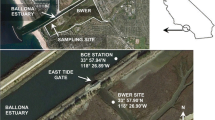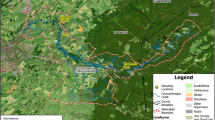Abstract
Environmental reservoirs of fecal indicator bacteria (FIB) are attracting increasing attention because of the ambiguity they present when assessing the microbial quality of water. FIB can survive and even grow in various environmental reservoirs which means FIB measured in the water column may not have originated directly from a fecal source. Sediment and periphyton, i.e., aquatic biofilms growing on submerged rocks, have been shown to harbor large populations of FIB in the environment. However, little is known about the spatial and temporal dynamics of FIB in periphyton. The objective of this work was to determine levels of the common FIB, Escherichia coli and enterococci, in creek water, sediment, and periphyton during the summer and winter. FIB were measured during two summer and winter sampling dates at five locations along a 2.8-km stretch of creek in Beltsville, Maryland. Significant differences in FIB by location were only observed for E. coli in water at one time point. Levels of FIB significantly declined from summer to winter in all media. FIB concentrations in periphyton ranged from 102 to 104 gdw−1 in the summer and from 100 to 104 CFU gdw−1 in the winter. When compared on a dry weight basis, periphyton contained higher concentrations of FIB than the sediment. Variability of FIB was in the order of water < sediment < periphyton. Levels of E. coli and enterococci measured in the same sample showed significant positive correlation in all media (rs = 0.87, 0.48, 0.70, for water, sediment, and periphyton, respectively). Results from this work show that fecal bacteria can persist in creek periphyton which may act as both a reservoir for fecal pathogens as well as a probable source of fecal bacteria to the water column.


Similar content being viewed by others
References
Allende, A., & Monaghan, J. (2015). Irrigation water quality for leafy crops: a perspective of risks and potential solutions. International Journal of Environmental Research and Public Health, 12(7), 7457–7477.
Balzer, M., Witt, N., Flemming, H. C., & Wingender, J. (2010). Faecal indicator bacteria in river biofilms. Water Science and Technology, 61(5), 1105–1111.
Blaustein, R. A., Pachepsky, Y., Hill, R. L., Shelton, D. R., & Whelan, G. (2013). Escherichia coli survival in waters: temperature dependence. Water Research, 47(2), 569–578.
Byappanahalli, M. N., Sawdey, R., Ishii, S., Shively, D. A., Ferguson, J. A., Whitman, R. L., & Sadowsky, M. J. (2009). Seasonal stability of Cladophora-associated Salmonella in Lake Michigan watersheds. Water Research, 43(3), 806–814.
Cantonati, M., & Lowe, R. L. (2014). Lake benthic algae: toward an understanding of their ecology. Freshwater Science, 33(2), 475–486.
Carr, G. M., Morin, A., & Chambers, P. A. (2005). Bacteria and algae in stream periphyton along a nutrient gradient. Freshwater Biology, 50(8), 1337–1350.
Cho, K. H., Pachepsky, Y. A., Kim, J. H., Guber, A. K., Shelton, D. R., & Rowland, R. (2010). Release of Escherichia coli from the bottom sediment in a first-order creek: experiment and reach-specific modeling. Journal of Hydrology, 391(3–4), 322–332.
Cinotto, P. J. (2005). Occurrence of fecal-indicator bacteria and protocols for identification of fecal-contamination sources in selected reaches of the West Branch Brandywine Creek, Chester County, Pennsylvania. Reston: US Department of the Interior, US Geological Survey.
Cooper, I. R., Taylor, H. D., & Hanlon, G. W. (2007). Virulence traits associated with verocytotoxigenic Escherichia coli O157 recovered from freshwater biofilms. Journal of Applied Microbiology, 102(5), 1293–1299.
Davies, C. M., Long, J. A., Donald, M., & Ashbolt, N. J. (1995). Survival of fecal microorganisms in marine and freshwater sediments. Applied and Environmental Microbiology, 61(5), 1888–1896.
de Souza, M. L., Pellegrini, B. G., & Ferragut, C. (2015). Periphytic algal community structure in relation to seasonal variation and macrophyte richness in a shallow tropical reservoir. Hydrobiologia, 755(1), 183–196.
Derlet, R. W., Richards, J. R., Tanaka, L. L., Hayden, C., Ger, K. A., & Goldman, C. R. (2012). Impact of summer cattle grazing on the Sierra Nevada watershed: aquatic algae and bacteria. Journal of Environmental and Public Health, 2012. https://doi.org/10.1155/2012/760108
Englebert, E. T., McDermott, C., & Kleinheinz, G. T. (2008). Effects of the nuisance algae, Cladophora, on Escherichia coli at recreational beaches in Wisconsin. The Science of the Total Environment, 404(1), 10–17.
Ford, R. M., & Harvey, R. W. (2007). Role of chemotaxis in the transport of bacteria through saturated porous media. Advances in Water Resources, 30(6–7), 1608–1617.
Gaertner, J. P., Mendoza, J. A., Forstner, M. R., & Hahn, D. (2011). Recovery of Salmonella from biofilms in a headwater spring ecosystem. Journal of Water and Health, 9(3), 458–466.
Garzio-Hadzick, A., Shelton, D. R., Hill, R. L., Pachepsky, Y. A., Guber, A. K., & Rowland, R. (2010). Survival of manure-borne E. coli in streambed sediment: effects of temperature and sediment properties. Water Research, 44(9), 2753–2762.
Grant, S. B., Litton-Mueller, R. M., & Ahn, J. H. (2011). Measuring and modeling the flux of fecal bacteria across the sediment-water interface in a turbulent stream. Water Resources Research, 47(5). https://doi.org/10.1029/2010WR009460
Haglund, A. L., & Hillebrand, H. (2005). The effect of grazing and nutrient supply on periphyton associated bacteria. FEMS Microbiology Ecology, 52(1), 31–41.
Haller, L., Amedegnato, E., Poté, J., & Wildi, W. (2009). Influence of freshwater sediment characteristics on persistence of fecal indicator bacteria. Water, Air, and Soil Pollution, 203(1–4), 217–227.
Hammer, Ø., Harper, D. A., & Ryan, P. D. (2001). PAST: paleontological statistics software package for education and data analysis. Palaeontologia Electronica, 4(1), 9.
Ishii, S., Ksoll, W. B., Hicks, R. E., & Sadowsky, M. J. (2006). Presence and growth of naturalized Escherichia coli in temperate soils from Lake Superior watersheds. Applied and Environmental Microbiology, 72(1), 612–621.
Ishii, S., & Sadowsky, M. J. (2008). Escherichia coli in the environment: implications for water quality and human health. Microbes and Environments, 23(2), 101–108.
Jamieson, R., Joy, D. M., Lee, H., Kostaschuk, R., & Gordon, R. (2005a). Transport and deposition of sediment-associated Escherichia coli in natural streams. Water Research, 39(12), 2665–2675.
Jamieson, R. C., Joy, D. M., Lee, H., Kostaschuk, R., & Gordon, R. J. (2005b). Resuspension of sediment-associated Escherichia coli in a natural stream. Journal of Environmental Quality, 34(2), 581–589.
Kim, J. W., Pachepsky, Y. A., Shelton, D. R., & Coppock, C. (2010). Effect of streambed bacteria release on E. coli concentrations: monitoring and modeling with the modified SWAT. Ecological Modelling, 221(12), 1592–1604.
Koirala, S. R., Gentry, R. W., Perfect, E., Schwartz, J. S., & Sayler, G. S. (2008). Temporal variation and persistence of bacteria in streams. Journal of Environmental Quality, 37(4), 1559–1566.
Kovačić, A., Tripković, I., Galov, A., & Žitko, T. (2011). Distribution of microbiological indicators of fecal pollution in the riverine substrates. Environmental Monitoring and Assessment, 172(1–4), 623–630.
Ksoll, W. B., Ishii, S., Sadowsky, M. J., & Hicks, R. E. (2007). Presence and sources of fecal coliform bacteria in epilithic periphyton communities of Lake Superior. Applied and Environmental Microbiology, 73(12), 3771–3778.
Latorre, A. A., Van Kessel, J. S., Karns, J. S., Zurakowski, M. J., Pradhan, A. K., Boor, K. J., et al. (2010). Biofilm in milking equipment on a dairy farm as a potential source of bulk tank milk contamination with Listeria monocytogenes. Journal of Dairy Science, 93(6), 2792–2802.
Li, X., Peed, L., Sivaganesan, M., Kelty, C.A., Neitch, C., Shanks, O.C. (2017). Simultaneous measurement of genetic fecal indicators in water column and periphyton biofilms in artificial streams. Environmental Protection Agency. Poster presentation at Water Microbiology Conference, Chapel Hill, N.C, May 15 – 19th, 2017.
Mackowiak, M., Leifels, M., Hamza, I. A., Jurzik, L., & Wingender, J. (2018). Distribution of Escherichia coli, coliphages and enteric viruses in water, epilithic biofilms and sediments of an urban river in Germany. Science of the Total Environment, 626, 650–659.
Mathai, P. P., Dunn, H. M., Magnone, P., Zhang, Q., Ishii, S., Chun, C. L., & Sadowsky, M. J. (2019). Association between submerged aquatic vegetation and elevated levels of Escherichia coli and potential bacterial pathogens in freshwater lakes. Science of the Total Environment, 657, 319-324.
Moreira, S., Brown, A., Ha, R., Iserhoff, K., Yim, M., Yang, J., et al. (2012). Persistence of E scherichia coli in freshwater periphyton: biofilm-forming capacity as a selective advantage. FEMS Microbiology Ecology, 79(3), 608–618.
Muirhead, R. W., Davies-Colley, R. J., Donnison, A. M., & Nagels, J. W. (2004). Faecal bacteria yields in artificial flood events: quantifying in-stream stores. Water Research, 38(5), 1215–1224.
Mulling, B. T. M., van den Boomen, R. M., van der Geest, H. G., Kappelhof, J. W. N. M., & Admiraal, W. (2013). Suspended particle and pathogen peak discharge buffering by a surface-flow constructed wetland. Water Research, 47, 1091–1100.
Naranjo, R. C., Niswonger, R. G., Smith, D., Rosenberry, D., & Chandra, S. (2019). Linkages between hydrology and seasonal variations of nutrients and periphyton in a large oligotrophic subalpine lake. Journal of Hydrology, 568, 877–890.
Pachepsky, Y. A., Allende, A., Boithias, L., Cho, K., Jamieson, R., Hofstra, N., & Molina, M. (2018). Microbial water quality: monitoring and modeling. Journal of Environmental Quality, 47(5), 931–938.
Pachepsky, Y. A., & Shelton, D. R. (2011). Escherichia coli and fecal coliforms in freshwater and estuarine sediments. Critical Reviews in Environmental Science and Technology, 41(12), 1067–1110.
Pachepsky, Y., Stocker, M., Saldaña, M. O., & Shelton, D. (2017). Enrichment of stream water with fecal indicator organisms during baseflow periods. Environmental Monitoring and Assessment, 189(2), 51.
Pandey, P. K., Soupir, M. L., Ikenberry, C. D., & Rehmann, C. R. (2016). Predicting streambed sediment and water column Escherichia coli levels at watershed scale. JAWRA Journal of the American Water Resources Association, 52(1), 184–197.
Park, Y., Pachepsky, Y., Hong, E. M., Shelton, D., & Coppock, C. (2017). Escherichia coli release from streambed to water column during baseflow periods: a modeling study. Journal of Environmental Quality, 46(1), 219–226.
Phillips, M. C., Solo-Gabriele, H. M., Reniers, A. J., Wang, J. D., Kiger, R. T., & Abdel-Mottaleb, N. (2011). Pore water transport of enterococci out of beach sediments. Marine Pollution Bulletin, 62(11), 2293–2298.
Piorkowski, G., Jamieson, R., Bezanson, G., Hansen, L. T., & Yost, C. (2014). Reach specificity in sediment E. coli population turnover and interaction with waterborne populations. Science of the Total Environment, 496, 402–413.
Piorkowski, G. S., Jamieson, R. C., Hansen, L. T., Bezanson, G. S., & Yost, C. K. (2014). Characterizing spatial structure of sediment E. coli populations to inform sampling design. Environmental Monitoring and Assessment, 186(1), 277–291.
Romani, H. G. A. M. (Ed.). (2016). Aquatic biofilms. Caister Academic Press, Wymondham.
Rosemond, A. D. (1994). Multiple factors limit seasonal variation in periphyton in a forest stream. Journal of the North American Benthological Society, 13(3), 333–344.
Sha, Q. (2012). Distribution, diversity, and fate of salmonella in natural biofilms. (Doctoral dissertation). Retrieved from https://digital.library.txstate.edu/handle/10877/5493.
Smith, J.E., Stocker, M.D., Pachepsky, Y. (2019). The effect of temperature oscillations and sediment texture on fecal indicator bacteria survival in sediments. In Review. Journal of Environmental Quality.
Stocker, M. D., Penrose, M., & Pachepsky, Y. A. (2018). Spatial patterns of Escherichia coli concentrations in sediment before and after high-flow events in a first-order creek. Journal of Environmental Quality, 47(5), 958–966.
Stocker, M. D., Rodriguez-Valentin, J. G., Pachepsky, Y. A., & Shelton, D. R. (2016). Spatial and temporal variation of fecal indicator organisms in two creeks in Beltsville, Maryland. Water Quality Research Journal, 51(2), 167–179.
Traister, E., & Anisfeld, S. C. (2006). Variability of indicator bacteria at different time scales in the upper Hoosic River watershed. Environmental Science & Technology, 40(16), 4990–4995.
Tyrrel, S. F., & Quinton, J. N. (2003). Overland flow transport of pathogens from agricultural land receiving faecal wastes. Journal of Applied Microbiology, 94, 87–93.
USEPA.2012. Recreational water quality criteria; Office of Water, United States Environmental Potection Agency: Washington, D.C.
van Dam, A. A., Beveridge, M. C., Azim, M. E., & Verdegem, M. C. (2002). The potential of fish production based on periphyton. Reviews in Fish Biology and Fisheries, 12(1), 1–31.
Vogeleer, P., Tremblay, Y. D., Mafu, A. A., Jacques, M., & Harel, J. (2014). Life on the outside: role of biofilms in environmental persistence of Shiga-toxin producing Escherichia coli. Frontiers in Microbiology, 5, 317.
Whitman, R. L., Shively, D. A., Pawlik, H., Nevers, M. B., & Byappanahalli, M. N. (2003). Occurrence of Escherichia coli and enterococci in Cladophora (Chlorophyta) in nearshore water and beach sand of Lake Michigan. Applied and Environmental Microbiology, 69(8), 4714–4719.
Acknowledgements
The authors would like to acknowledge the help of the USDA’s Agricultural Research Learning Experience (ARLE) program along with the Hispanic Serving Institutions initiative for supporting researchers to help plan and conduct the work.
Funding
This work was supported through the USDA’s Agricultural Research Service project number 8042-12630-011-00D.
Author information
Authors and Affiliations
Corresponding author
Additional information
Publisher’s Note
Springer Nature remains neutral with regard to jurisdictional claims in published maps and institutional affiliations.
Electronic supplementary material
Supplemental Figure 1.
Flow and precipitation data recorded during the observation period. S1, S2, W1, and W2 represent sampling dates of 7/21/2017, 7/27/2017, 1/31/2018, and 2/6/2018, respectively. Panels a and b represent summer and winter sampling periods, respectively. (JPG 485 kb)
Supplemental Figure 2.
Cumulative probability distributions of E. coli and enterococci concentrations along the stream reach for the four observation periods. E. coli concentrations in water, sediment, and periphyton are presented in panels a, b, and c while enterococci in the same media are presented in d, e and f. (JPG 797 kb)
Supplemental Figure 3.
Comparison of FIB concentrations in periphyton as reported using different units. White circles and triangles represent E. coli concentrations in CFU gdw-1 and CFU cm-2, respectively. Black circles and triangles represent enterococci concentrations in CFU gdw-1 and CFU cm-2, respectively. (JPG 366 kb)
ESM 4
(DOCX 69 kb)
Rights and permissions
About this article
Cite this article
Stocker, M.D., Smith, J.E., Hernandez, C. et al. Seasonality of E. coli and Enterococci Concentrations in Creek Water, Sediment, and Periphyton. Water Air Soil Pollut 230, 223 (2019). https://doi.org/10.1007/s11270-019-4263-1
Received:
Accepted:
Published:
DOI: https://doi.org/10.1007/s11270-019-4263-1




